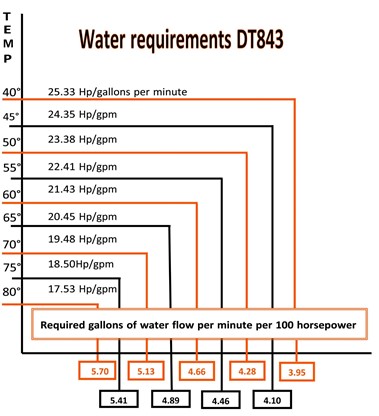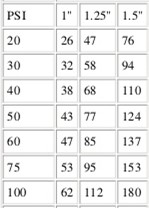Most dynamometers use water to aid in transferring heat generated during an energy conversion from power to heat, or even used as the loading media. In the case of high-capacity mechanical friction prony brake dynamometers water is only used to control the operating temperature of the brake during dynamic load cycles.
It must be understood that a mechanical prony brake does not require water to produce resistance. The creation of a dynamic load to a prime mover is independent of water pressure and volume when compared to a water brake dynamometer, which requires specific water pressures and volume to create load. With a prony brake being independent of water pressure and volume for loading capacity as a dynamometer they find themselves in a niche arena testing low rpm, high torque applications.
It is the mechanics of the brake rotor that transfers heat created at the point of friction into the cooling water. Radial actuated prony brake dynamometers used for PTO testing agricultural tractors only require a specific water flow for cooling of the brake’s rotor. Recommended flow is based on incoming water temperature, the amount of horsepower being absorbed, maximum water temperature and the length of the required test session.
Knowing that the norm is lack of available water flow at the service location, reducing session times, most PTO dynamometers have incorporated additional water reservoirs into the cooling system to extend testing times. Water is circulated within the reservoir by brake rotor rotation providing equal transfer of heat into the water. According to the size of the reservoir and the amount of horsepower being tested, even short sessions, can be achieved without water flowing into the cooling reservoir system. Although it is best to have water flowing through the system, it is the additional reservoir capacity which supplements extended test session times when the incoming flow is insufficient.
This type of dynamometer does not require high water pressure for either loading or proper cooling. These brakes only require water volume for cooling. The only pressure required is getting water to the incoming dynamometer water tank connection. This type of cooling system is a low-pressure system. The system is designed to produce a major water pressure drop from inlet to final drain, providing there are no restrictions in the discharge hose or by pushing discharge water long distances to final drain.
The Dyno Tech DT843 provides the maximum water-cooling efficiency for radial force prony brake dynamometers. We know you may not have sufficient flow for maximum extended test session times, but the DT843 provides you with the longest available session time in the PTO market. The DT843 does not require a minimum flow of water to operate.
The following chart provides dynamometer water volume requirements vs horsepower to be tested on an extended basis. The additional chart shows water flow volume [GPM] using different sizes of pipe and the amount of pressure required to produce the corresponding flow.


 Gallons Per Minute
Gallons Per Minute